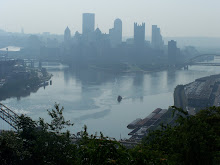We were treated to a tour of Pittsburgh today by Jan Dofner who is probably the best tour guide I've ever had. Her enthusiasm, her insider knowledge of the cultural heritage of Pittsburgh, her technical knowledge of how the mills worked, and the fun strategies she employed to bring the technical details to life made this an outstanding one. It sounded like Jan was an active member of the Rivers of Steel Heritage Area, an preservation organization you can find out more information about at http://www.riversofsteel.com/home.aspx?h=219&sn=310
First recognized by General George Washington as a great spot for a fort during the Revolutionary War because of the convergence of the three rivers here, Pittsburgh gained its lasting fame when industrialists saw Pittsburgh’s potential for manufacturing steel.
The Bessemer furnace invented in the mid 19th-century made it possible for the first time to mix together large amounts of iron, coke (a form of coal), and limestone, the three ingredients needed to make steel. Nineteenth-century steel workers in Pittsburgh had to endure 2800 degree heat and were required to somehow manually dump 100 lbs. of iron into the blazing furnaces. These steel workers were paid 16 cents an hour and according to Jan had to work 12-hour shifts from 3 a.m.-3 p.m. with one 24-hour shift at the end of a two-week cycle followed by just one day off. It was necessary for the workers to work these ridiculous hours because the furnace ran 24-hours a day. Not surprisingly many of the accidents occurred during those 24-hour shift.
Our first stop was to Station Square, a major tourist destination populated by waterfront restaurants, a Sheraton, and bike path. An old-style Bessemer furnace stands in front of the Hard Rock Café. And it was here we learned of the ridiculous physical stress and danger the steel workers had to endure to work the furnaces. The highlight of this stop came at 9 a.m. when the water show started up, surprising us all. The water spouts swayed back and forth to the score of Flashdance--"in a world made of steel, made of stone". I couldn't stop laughing. I kind of wanted to dance.
The best view of the point (the triangle of land formed where the Allegheny, Ohio and Monongahela Rivers converge) is at a lookout point on the South Side of the city. The view includes the point, the ballpark just across the river, and Pittsburgh’s numerous bridges. It was from this vantage point that you could visually see all the elements that made Pittsburgh the perfect site to manufacturing and transport steel from. The rivers provide the means of transportation to ship out goods to the rest of the country, the flat banks of the river provided the perfect place to lay the train tracks which transported even more steel out. Finally, Pittsburgh happened to be the site of a major coal reserve. Jan emphasized throughout her tour that the story of the steel industry is the story of an amazing supply chain, with industrialists orchestrating the constant movement of huge quantities of goods in a timely manner.
Bost Buidling, one of the few buildings that remains of the several acre large Homestead steel town, was the site of the first organized activity against Big steel as early as the 1930s. The first real unions did not come until the 1950s which is when you see the first protective equipment being worn by steel workers!
Standing just on the other side of the river from Carrie, one of the last remaining old style mills and recently named a National Historic Site, the Pump House was where they pumped tons of water out of and back into the river to cool the furnaces. The river bank just outside the Pump House was the site of the Battle of Homestead in 1892, one of the bloodiest battles waged by the steel workers.
We made our last stop of the day at the Bulgarian-Macedonian Club, a cultural preservation center for Bulgarian culture in Pittsburgh. Family owned and operated, they served up a soup lunch and teach Bulgarian dance. The center also houses some great artwork. The apple streudel I had there was the best I’ve had anywhere. Really flaky, dusted with the perfect amount of powdered sugar and filled with real apples and walnuts. The moistness of the filling contrasted the flakiness of the shell nicely.
Between stops, we sang songs including Woody Guthrie’s “Pittsburgh Town” and steelworker Andrew Kovaly’s “Aja Lejber Man” (I’m a working man). I loved the honesty and forthrightness of the lines “I’m a working man / I work every day. / Always I am dreaming, / Always I am counting, / ‘How many dollars am I savings?’” The play on words in the line “What did Jones & Laughlin steal” in the song “Pittsburgh Town” would be a great question to pose to high school students studying the Industrial Revolution.
Thursday, July 10, 2008
Subscribe to:
Post Comments (Atom)

























No comments:
Post a Comment